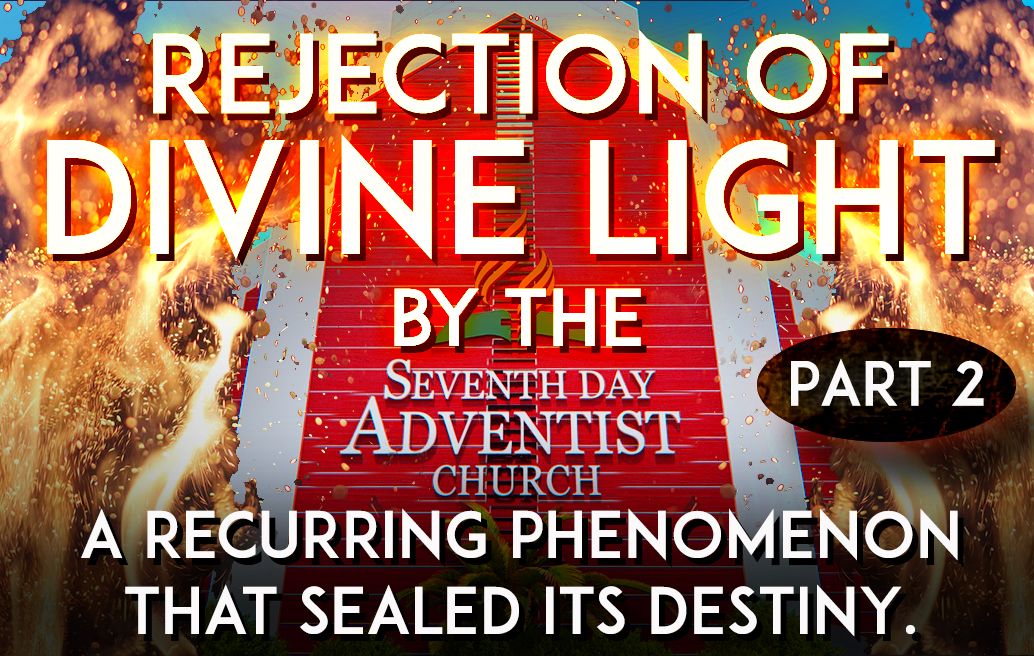Rejection of Divine light by the SDA Church: A recurring phenomenon that sealed its destiny. (Part 2 of 3)
|
The church's history shows a repeated, blatant rejection of divine light during its early development, which caused it to cease receiving new light. |

The notion that the Seventh-day Adventist Church's rejection of divine light has been a recurring phenomenon that has "sealed its destiny" is a significant point of theological and historical reflection. This concept suggests that the Seventh-day Adventist Church, at various junctures in its history, has either failed to fully recognize or accept certain divine revelations or truths that were presented to it, which could have had a lasting impact on its growth, doctrinal clarity, and its broader influence in the world.
To explore this historical reality, it is essential to examine two key events in which the church profoundly rejected Yahuwah’s light in pursuit of acceptance from Christendom and mainstream ‘science.’ These two rejections involve the flat earth concept [click here to read this article] and the Lunar Sabbath. This article will focus on rejecting the Lunar Sabbath light that occurred early in the twentieth century.
Historical background:
The date of October 22, 1844, along with the Great Disappointment, created a theological crisis for early Adventists. However, it also led to a deeper study of biblical prophecy and timekeeping. The lunar Sabbath dilemma arose as some Adventists sought to reconcile the Sabbath with the lunar cycle, partly due to questions raised by the events of 1844. Nevertheless, the Seventh-day Adventist Church rejected the lunar Sabbath theory in favor of its ‘traditional belief’ in a fixed, continuous weekly Sabbath, rooted in the creation week and the fourth commandment.
The Lunar Sabbath Dilemma:
The lunar Sabbath theory emerged as a response to the October 22, 1844 date and the understanding of Sabbath observance within the Adventist community. Some movement members began to question whether the Sabbath was genuinely a fixed, continuous seven-day week or whether it should be linked to the lunar cycle, where a new moon signifies the beginning of a new month. Proponents of the lunar Sabbath theory argued that the Sabbath was meant to fall on the seventh day after the new moon day of each lunar cycle, indicating that it would change each month and that the Sabbath was initially associated with the moon’s phases rather than the continuous weekly cycle.
The church leadership found it challenging to accept the shifting of the Sabbath day each month in the Gregorian calendar. There were concerns that embracing such a change, even if supported by biblical texts, would unsettle the congregation and potentially cause a divide among members: those who wanted to maintain the traditionally fixed Sabbath based on the continuous weekly cycle and those who aimed to observe the biblical Sabbath regardless of the disruptions that such adherence might entail.
The Grace Amadon Files and Their Contribution to Lunar Sabbath Research:
The Grace Amadon files consist of her research, letters, articles, and other materials related to the lunar calendar and its connection to the biblical Sabbath. These files document her findings, conclusions, and arguments regarding the lunar cycle and its relation to the biblical Sabbath. Some of the key points from the Grace Amadon files include:
- Lunar Sabbath Argument: Amadon argued that the biblical Sabbath was not based on a weekly cycle, as traditionally observed by most Christians and Seventh-day Adventists, but was instead determined by the phases of the moon. According to Amadon, the Sabbath occurred on the seventh day of the lunar cycle, meaning it would change each month depending on the timing of the new moon.
-Calendar Systems: Amadon’s research also examined the use of lunar calendars in ancient times and the historical evidence suggesting that the Sabbath may have been initially observed in connection with the lunar cycle. She explored various calendar systems, including the lunar calendar used in ancient Israel and the potential biblical basis for a luni-solar calendar.
-Criticism of the Continuous Weekly Cycle: One of the main criticisms in Amadon’s files is the belief that the continuous weekly cycle—advocated by the SDA Church—is an inaccurate interpretation of how the Sabbath was observed in the Bible. According to Amadon and other lunar Sabbath proponents, the fixed weekly cycle introduced by the Gregorian calendar does not align with the biblical calendar system and is not in harmony with how the Sabbath was originally intended to be observed.
-New Moon Day: The study acknowledged the New Moon as a significant event in the ancient Hebrew calendar, distinguishing it from the Sabbath. The New Moon is recognized as the first day of the month and the day that resets the four weekly Sabbaths within each lunation.
Despite the irrefutable findings presented in Grace Amadon’s research and their implications for the connection between the biblical Sabbath and the lunar cycle, the Seventh-day Adventist Church chose to reject the Lunar Sabbath. This decision resulted in a failure to embrace divine truth and biblical accuracy in order to maintain the status quo of traditional weekly Sabbath observance. The leadership could not accept the idea of admitting to both members and Sabbath opponents that they were fundamentally mistaken about such a crucial teaching of the church. They opted for an easier way out of this dilemma. The church consistently preferred the status quo over embracing new divine rays of light.
Consequently, the Seventh-day Adventist Church upheld the continuous weekly cycle to preserve its traditional Saturday Sabbath, primarily relying on Ellen White’s writings that advocate for this uninterrupted weekly cycle. They disregarded the findings presented in Grace Amadon’s files to maintain church unity and tradition. By rejecting divine light in this manner, the Seventh-day Adventist Church has, once again to its own fatal detriment, chosen to please man rather than Father Yahuwah; prioritized convenience over principle.
Conclusion:
We are convinced that Father Yahuwah has ceased bestowing any new light on the Seventh-day Adventist Church. After flatly rejecting Yahuwah’s model of biblical creation in the late nineteenth century and substituting it with Satan’s inspired globe model, along with the rejection of the biblical Sabbath and lunisolar calendar for identifying the Sabbath, the church adopted the Trinity doctrine in the early 1980s to become a fully integrated mainstream denomination. By turning its back on the one God, Father Yahuwah, and replacing Him with a pagan three-in-one god, the Seventh-day Adventist Church has doomed its eternal destiny. Worse still, by accepting the Trinity doctrine, they have, in effect, adopted a christ incapable of bestowing eternal life on anyone- a Platonic christ, which is the product of Greek mythology and is as lifeless as a piece of rock. These sad realities confront the sincere believers still trapped within this fallen church with a choice: do you stay and share its doom, or do you flee for your life?
We urge you to flee for your life!








